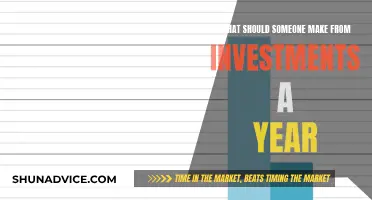
Building an investment portfolio can be intimidating, but there are steps you can take to make the process painless. The first step is to decide the level of risk you're comfortable with. Higher-risk investments can generate high rewards, but they can also result in large losses. Generally, investing in stocks produces the highest returns, while investing in bonds increases the stability of the value of your portfolio.
You should also consider your financial goals. For example, are you saving for retirement, or do you want to start a business?
Once you've determined your risk tolerance and financial goals, you can start thinking about the types of investments you want to include in your portfolio. Stocks, bonds, mutual funds, exchange-traded funds (ETFs), and real estate are all common types of investments.
Finally, you'll need to choose an account to hold your investments. A taxable brokerage account is a good option if you want to be able to access your money at any time without paying an early withdrawal penalty. If you're investing for retirement, a tax-advantaged account like a 401(k) or IRA may be a better choice.
| Characteristics | Values |
|---|---|
| Risk tolerance | High-risk investments can generate high rewards, but they can also result in large losses. |
| Time horizon | The longer the time horizon, the greater the ability to recover from potential market declines. |
| Investment goals | Retirement, child's college tuition, large purchases, starting a business, etc. |
| Investment types | Stocks, bonds, mutual funds, exchange-traded funds (ETFs), real estate, cash equivalents, etc. |
| Diversification | Spread investments across different asset types and tax-exposure strategies. |
| Investment accounts | Tax-advantaged retirement accounts (401(k), IRA), taxable brokerage accounts. |
What You'll Learn

Understanding risk tolerance and asset allocation
Understanding your risk tolerance and determining your asset allocation are crucial steps in building an investment portfolio.
Risk tolerance refers to your ability to accept potential losses in pursuit of higher investment returns. It is influenced by factors such as your age, time horizon, financial situation, and personality. Younger investors with a longer time horizon before retirement can generally tolerate more risk and focus more on growth-oriented investments like stocks. On the other hand, older investors approaching retirement typically have a lower risk tolerance and may shift their portfolios towards more conservative investments like bonds. It's important to be honest with yourself about your risk tolerance to avoid emotional investing mistakes.
Asset allocation involves dividing your capital among different asset classes, such as equities (stocks) and bonds. A well-diversified portfolio is essential for consistent long-term growth. Diversification helps smooth out returns over time, as different investments perform well at different times. When determining your asset allocation, consider your risk tolerance, financial goals, and time horizon. Generally, a more aggressive portfolio will allocate a larger portion to equities, while a more conservative portfolio will focus more on bonds and other fixed-income securities.
Additionally, you can further diversify your portfolio by investing in various subclasses within each asset class. For example, you can divide equities among different sectors, market capitalizations, and domestic or foreign stocks. Similarly, bonds can be categorized by maturity, coupon rate, type, and credit rating. Mutual funds and exchange-traded funds (ETFs) are also popular investment options that provide automatic diversification across a wide range of stocks or bonds.
Remember, investing involves risks, and there is no one-size-fits-all approach to building an investment portfolio. It is important to carefully consider your personal circumstances, goals, and risk tolerance before making any investment decisions.
Social Security Investment Strategies: Maximizing Your Savings
You may want to see also

Choosing an investment account
There are several different types of investment accounts, and the right one for you will depend on your goals and preferences. Here are some options to consider:
- Retirement accounts: These include 401(k)s, 403(b)s, traditional IRAs, and Roth IRAs. They offer tax advantages, with traditional options being pre-tax and Roth options being after-tax. For example, contributions to traditional 401(k)s and IRAs are made pre-tax, lowering your taxable income for the year, while Roth 401(k)s and IRAs offer tax-free withdrawals in retirement. It's worth noting that Roth IRAs have an income limit, while traditional IRAs do not. Both have a contribution limit of $6,000 per year, with an additional $1,000 catch-up contribution for individuals aged 50 or older.
- Taxable brokerage accounts: These accounts are suitable for non-retirement goals, such as saving for a down payment on a house. They offer more flexibility, as you can access your money at any time without paying an early withdrawal penalty.
- Robo-advisor accounts: These accounts are ideal for those who prefer a more hands-off approach. You'll typically fill out a questionnaire to assess your risk tolerance, financial goals, age, and other factors, and the robo-advisor will use an algorithm to create a customised portfolio. However, note that many robo-advisors charge an account fee on top of the expense ratios charged for investing in each fund.
- Brokerage accounts: These accounts allow you to buy and sell individual stocks and bonds freely. Some brokerage platforms offer $0 commission trading, meaning you don't have to pay the brokerage to execute trades.
When choosing an investment account, it's important to consider your short-term and long-term financial goals, your risk tolerance, and the level of involvement you want to have in managing your investments. Additionally, keep in mind that you can diversify your investment portfolio by holding multiple types of accounts and multiple types of investments within those accounts.
Saving and Investment Macroeconomics: The Basics of Money Management
You may want to see also

Selecting investments based on risk tolerance
When building an investment portfolio, it is important to understand your risk tolerance, which is the degree of risk that an investor is willing to accept given the volatility in the value of an investment. Knowing your risk tolerance will help you plan your portfolio and determine how you invest.
There are three main categories of investors based on their risk tolerance: aggressive, moderate, and conservative. Aggressive investors have a high-risk tolerance and are willing to risk losing money to achieve potentially better results. They tend to be market-savvy and invest in stocks with little to no allocation to bonds or cash. Moderate investors, on the other hand, aim to balance opportunities and risks. They usually develop a portfolio that includes a mixture of stocks and bonds. Finally, conservative investors have a low-risk tolerance and seek investments with guaranteed returns. They prioritise capital preservation and often invest in low-risk options such as bank certificates of deposit (CDs), money markets, or US Treasuries.
Your risk tolerance will depend on several factors, including your age, investment goals, income, and comfort level. Younger individuals are generally able to take on more risk, as they have more time to recover from potential losses. Additionally, your investment goals will influence your risk tolerance. If you have a long-time horizon, you may be able to generate greater returns by investing in higher-risk assets. On the other hand, if you have short-term financial goals, lower-risk cash investments may be more appropriate.
It is important to assess your risk tolerance before selecting investments for your portfolio. Online risk-tolerance questionnaires can be a useful tool to help you understand your risk tolerance and determine the appropriate asset allocation for your portfolio.
Saving and Investing: Building Wealth and Security
You may want to see also

Determining the best asset allocation
When determining the best asset allocation for your investment portfolio, there are several factors to consider. These include your financial goals, risk tolerance, and time horizon.
Firstly, it is important to identify your investing goals. Are you investing for retirement, to save for your child's college tuition, or to make a large purchase such as a house? Each financial goal will have its own time horizon, which is the length of time you have to invest before you need to withdraw the money. For example, if you are saving for retirement, consider when you want to retire. If you are saving for college, your time horizon will depend on when your children will reach college age and how many years of school you plan to pay for.
Next, you should assess your comfort with investment risk. Are you comfortable with the ups and downs of the market, or do you prefer a more stable investment option? Your risk tolerance will depend on factors such as your age, financial situation, and personality. Younger investors who are just starting their careers may be able to take on more risk, as they have more time to recover from potential market declines. On the other hand, older investors who are closer to retirement may prefer more conservative investments to protect their assets.
Your risk tolerance and time horizon will help determine the optimal portfolio mix for you. A portfolio with a higher allocation of equities will typically have higher risk and higher return expectations, while a portfolio with more fixed-income investments will have lower risk and lower return expectations.
- Aggressive portfolio: This type of portfolio is suitable for investors with a higher risk tolerance. It is mainly focused on equities, with a smaller allocation of bonds and other fixed-income securities.
- Moderate portfolio: This type of portfolio balances risk and return by investing in a mix of equities and fixed-income investments, such as bonds.
- Conservative portfolio: The main goal of a conservative portfolio is to protect its value. It may include a mix of bonds and high-quality equities, providing current income and some long-term capital growth potential.
It is also important to consider diversification when determining your asset allocation. Diversification involves spreading your investments across multiple types of assets, sectors, and industries to reduce risk. Mutual funds and exchange-traded funds (ETFs) are great options for beginners to achieve diversification, as they provide exposure to a wide range of companies and sectors.
Additionally, you may want to consider different types of investment accounts, such as tax-advantaged retirement accounts (e.g. 401(k) or IRA) and taxable brokerage accounts, to further diversify your portfolio and take advantage of tax benefits.
Remember, it is important to periodically reassess and rebalance your portfolio to ensure it remains aligned with your financial goals, risk tolerance, and time horizon.
Demand-Supply Equilibrium: Savings, Investments Balance
You may want to see also

Rebalancing your investment portfolio
Once you have established your investment portfolio, it is important to periodically rebalance it to ensure it remains aligned with your financial goals and risk tolerance. This is because, over time, the value of your assets will change, causing your portfolio's composition to deviate from your chosen asset allocation. For example, if you originally invested 50% in stocks and 50% in bonds, a strong performance from stocks might cause this to shift to 60% stocks and 40% bonds.
Rebalancing your portfolio means buying and selling assets to return it to your chosen asset allocation. In the example above, you would sell 10% of your stocks and use the proceeds to buy more bonds. This would return your portfolio to its original 50/50 split.
There are two main approaches to rebalancing: calendar-based and trigger-based. Calendar-based rebalancing involves adjusting your portfolio at regular intervals, such as quarterly or annually. Trigger-based rebalancing, on the other hand, involves rebalancing when your portfolio deviates beyond certain limits, such as when an asset class changes by 10% or more relative to its target allocation.
The frequency with which you rebalance your portfolio is a personal decision, depending on factors such as your age, risk tolerance, and transaction costs. However, it is generally recommended to rebalance at least once a year.
When rebalancing your portfolio, it is important to consider the tax implications of selling profitable investments. You may be able to avoid capital gains taxes by using new cash contributions to purchase assets in underweighted classes, or by using tax-loss harvesting to offset capital gains with capital losses. Alternatively, you could place your portfolio in a tax-advantaged account, such as an individual retirement account (IRA), and avoid taxes until you start withdrawing from the account.
Saving Plans: The Benefits of a Conservative Financial Strategy
You may want to see also
Frequently asked questions
An investment portfolio is a collection of assets and can include stocks, bonds, mutual funds, exchange-traded funds (ETFs), real estate investments, and cash equivalents.
The appropriate asset allocation depends on your investment goals and risk tolerance. Consider your age, time horizon, capital to invest, future income needs, and personality. Generally, younger investors can take on more risk and allocate a larger portion of their portfolio to equities, while older investors may opt for more conservative portfolios with a higher percentage of bonds and other fixed-income securities.
There are various types of investments to choose from, including stocks, bonds, mutual funds, ETFs, real estate investment trusts (REITs), and cash equivalents such as certificates of deposit (CDs) or savings accounts. Diversification is key, so aim for a mix of asset types to manage risk and smooth out returns over the long run.







